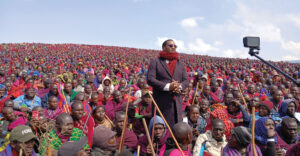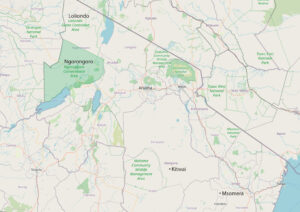by Ben Taylor

Thousands of Maasai gather to protest against evictions and are addressed by Arusha Regional Commissioner, Paul Makonda – Photo – IWGIA
Maasai evictions – and protests – and concessions
On August 18, 2024, hundreds of Maasai community members gathered to protest the denial of basic rights and the loss of their ancestral land in Ngorongoro, Tanzania. The protest is the latest in a series of actions against a government relocation plan aimed at moving 110,000 Maasai from Ngorongoro to Msomera, Sauni, and Kitwai, over 300 kilometers from their current homes.
Dressed in their traditional red clothing and holding leaves – as a symbol of peace recognized across many Tanzanian tribes – the demonstrators blocked the busy Ngorongoro-Serengeti Road. They carried posters, prayed, and marched, singing in the Maasai language to voice their grievances.
The government argues the relocation is essential to preserve the Ngorongoro Conservation Area, a UNESCO World Heritage site. “Due to escalating human-wildlife conflicts, overpopulation of humans and livestock, wide-spreading zoonotic diseases, shrinking wildlife corridor and grazing land, lack of safe water sources and poor sanitation, and the quest for socio-economic development of its citizens, the consensus was reached through a participatory and transparent process for a voluntary relocation program,” said Mudrik Ramadhan Soraga, the Zanzibar minister for Tourism and Heritage, speaking to a meeting of the World Heritage Committee in July in New Dehli, India.
Officials further maintain the relocation is voluntary, but residents have described the exercise as an eviction, pointing to the cutting off of essential services such as water and health to make their case. “Conservation is a good thing, we are not against it. We are against … discriminatory conservation, implemented in a militaristic way,” Maasai lawyer Denis Oleshangay told reporters. However, he said, “they are trying to make life so hard that no one will stay.”
The government has offered to build new homes to encourage “voluntary relocation” for those who agree to move to Msomera, as well as cash payments to support the move. The government reported having spent TSh 286 billion on the relocation effort, and said in early September that this has resulted in 9,778 residents moving since July 2022.
The immediate trigger for the latest protest appeared to be concerns that residents had been stripped of their right to vote in Ngorongoro. On August 3, some Ngorongoro residents alleged that the Independent National Electoral Commission (INEC) had transferred the names of voters from Ngorongoro to Msomera, a place where only 2% of Ngorongoro residents have relocated.
“We are shocked and saddened that the entire Ngorongoro Division, which currently has a population of 110,000, will not be voting at usual polling stations,” said James Moringe Mollel, Councillor of Loitile Ward. “They claimed the relocation was voluntary, but for example, I have been assigned to a hamlet in Msomera as my polling station, a place I’ve never even visited.”
Further, an official plan contained in the Government Gazette published on August 2, 2024, involved delisting 11 wards, 25 villages and 96 sub villages in Ngorongoro.
Prof Issa Shivji, one of Tanzania leading legal scholars, responded in a social media post that the villages’ delisting will have far-reaching legal and democratic implications for the people of Ngorongoro, and urged authorities to rethink their plan.
The protest than began on August 18th continued uninterrupted for five days, despite heavy-handed policing. According to some reports, this included the arrest of 39 members of the Maasai community. A week later, according to these same reports, the locations where the arrested were being held had not been revealed, and no charges had been brought.
The international human rights group, Amnesty, issued a statement calling on the government “to immediately disclose the whereabouts of the 40 arrested community members, grant them access to their lawyers, and due process, including being promptly brought before court to challenge the legality of their detention.”
Five days into the protest, the minister of State in the Prime Minister’s Office responsible for Policy, Parliamentary Affairs and Coordination, William Lukuvi, addressed residents in Oloirobi Village, in Ngorongoro Ward. He was accompanied by the Minister of Constitutional and Legal Affairs, Prof Palamagamba Kabudi, Deputy Minister of Natural Resources and Tourism, Mr Danstan Kitandula, Arusha Regional Commissioner, Paul Makonda, and the Police Force’s Commissioner of Operations and Training, Awadh Juma Haji.
Mr Lukuvi said in his speech that he had been sent by President Samia Suluhu Hassan, and that he had been instructed to ensure health and education services must continue to be adequately delivered. “Education services must be fully provided, and hospital services must be fully available. I want Mr Makonda to ensure that in all areas where services have been suspended, they are restored so that residents do not face difficulties in accessing social services,” he stated.
Mr Lukuvi also said that President Hassan has directed that local government elections, scheduled for November, should be held in Ngorongoro, and preparations should proceed accordingly in the area as per existing boundaries. “The President has sent us to assure you that your rights to vote in the forthcoming elections remain intact. The director of Elections (from the Independent National Electoral Commission) will ensure all polling stations are set up to enable citizens to exercise their constitutional rights,” he said.
At the same meeting, Prof Kabudi affirmed that all Tanzanians are equal and assured the residents that they will receive the same rights and treatment as those in other regions.
“Our country was founded by the Father of the Nation, Mwalimu Julius Nyerere, as one united nation built on love, peace, and unity. President Hassan upholds these principles and urges you to preserve peace and stability while safeguarding the nation. Let us embody the spirit of peace and love, just like all other Tanzanians,” he said.
In a separate development, the Arusha High Court has blocked implementation of the Government Notice that formally dissolved wards, villages, and hamlets, including those in the Ngorongoro District, until further court notice.
Thanking the government on behalf of the residents, Ngorongoro legislator Emmanuel Shangai said in the previous four years, residents have seen no leaders visiting the area, but today the President has sent them. “I urge you to trust the government because the President is for all Tanzanians. It is possible that some of her subordinates misled her, which is why these issues arose,” he said.
The government case
A series of articles in the (Tanzanian) Guardian newspaper presented the government case on the Ngorongoro issue, highlighting the legacy of a 1959 land use policy. Initially designed to accommodate human and wildlife populations, the policy aimed to harmonize their coexistence within the Ngorongoro Conservation Area (NCA).
The Maasai were allowed to graze their livestock within the conservation area, maintaining their cultural practices and livelihood. And in return, certain restrictions were imposed to ensure that wildlife habitats were preserved and that the ecological integrity of the region was not compromised. These restrictions included prohibiting permanent structures and agricultural activities that could disrupt wildlife habitats.
However, over time, the growth of both human and wildlife populations has intensified the competition for scarce resources like water and grazing land. Pressure on wildlife habitats intensified, leading to more frequent and severe human-wildlife conflicts.
Recently, the Tanzanian government, through the Ngorongoro Conservation Authority Area (NCAA), announced its goal to improve the living conditions of residents in the Ngorongoro division, especially those within the conservation area. This aims to separate human and wildlife habitats to enhance conservation efforts.

